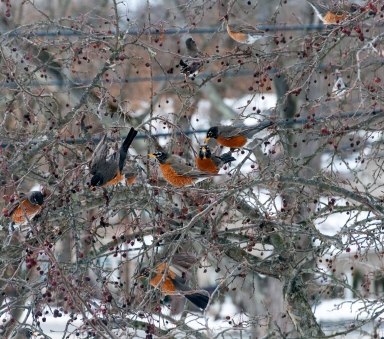
As I mentioned a couple of blog posts ago, I am leaving a lot of seed heads on my end of season perennials in hopes that the seeds will become bird food. Since I’m only a beginner birder, I’m doing this without any real understanding of who will eat it and when—and why certain seed heads or fruits stay on the plant so long.
So it was serendipitous that the last program in my Naturalist Training at Bowman’s Hill Wildflower Preserve, given by Master Naturalist Dr. Ed Lignowski, included some details about which birds eat what and when, from mid-summer through winter. Dr. Lignowski focused on how specific fruiting plants and birds had co-evolved, so that the plants provided fruit for the birds and the birds dispersed the seeds by pooping them out in a location away from the parent plant. While Dr. Lignowski didn’t specifically talk about plants that don’t produce what we think of as fruits, being “only” seed heads, his information provides a framework from which you can make your own observations and gain an understanding of what needs various plant foods are meeting for birds. I will have to do research on the seeds I am leaving on my plants for a future blog post, or this one will be too long.
It makes sense that birds who are about to migrate need to chow down and stock up on energy for their trip (they may do this several times, during stops along the way). What became clearer from Dr. Lignowski’s presentation was that these birds cannot just chow down on whatever is around—they specifically need foods that are high in lipids. So, these birds aren’t the ones eating the blueberries, blackberries, black cherries, and service berries that ripen from mid to late summer, since these fruits are “characterized by high sugar/low fat content.” It is resident birds, not migratory birds, that eat these fruits—and the fruits become ripe just as the resident birds switch off eating the main flush of insects in spring.
Just a quick aside—did you know that even hummingbirds have a diet that is 80% insects? The availability of insects that can serve as food, especially an abundance of caterpillars, is crucial to most birds’ ability to successfully rear their young.
Getting back to plant food. With these high sugar fruits, just as for humans, it is the change in fruit color that signals to the birds that the fruit is ripe. For example, blueberries go from green to pink to dark purple as they ripen, which, due to co-evolution, also coincides with the readiness of the seed inside the fruit to be dispersed by a pooping bird.
A separate group of especially “high quality” fruits ripen just in time for fall migration, including spicebush, flowering dogwood, sassafras and Virginia creeper. These fruits are those high in the lipids which provide energy for migration and are not sweet enough to be attractive to mammals, so there is less competition for them. The migrating birds feed “voraciously” and “deposit seeds locally,” otherwise known as pooping the seeds out in the area surrounding the plants that the fruits originated from. The migratory birds are tipped off to the ripening of these high-lipid fruits by “foliar fruit flags”—a change in leaf color that quickly alerts the birds where to go for ripe fruit. It seems New Jersey’s own Dr. Ted Stiles first did a study of these foliar flags. Marcia Bonta, a naturalist with more than 300 articles and 9 books to her credit, followed onto his work in explaining that fruits high in lipids rot quickly, so it is crucial that the plant attract birds to eat the fruit while the seeds are still viable. (Appalachian Autumn, University of Pittsburgh Press, 1994). Thus, the plant needs a clearly visible signal in the form of the foliar flags to get birds to the fruits just in time.
Still other plants provide food for resident birds during or at the end of winter, including hawthorns, chokeberry, poison ivy, viburnum, and winterberry holly. These fruits are “low quality” in terms of concentrated energy, being low in lipids, and thus are passed up by migratory birds. While the fruits are on the plants from fall through winter, anyone with a winterberry holly knows that birds often don’t get around to eating them until the end of winter/early spring, suggesting there are more desirable foods around, even for resident birds. Obviously, these fruits must not be prone to easy rotting, as they often remain on the plant for months.


As this picture of a yellow-rumped warbler eating poison ivy fruit shows, some of the latter fruits are eaten by birds that are semi-resident and semi-migratory. Yellow-rumped warblers live in our area from fall through spring, then summer further north of us.

See Mary Anne Borge’s blog at https://the-natural-web.org/ for more bird and other photos.